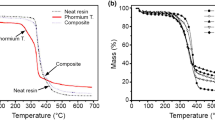Abstract
This work is part of a larger project whose main objective is a better understanding of the mechanism of adhesion between the surface of carbon fibres and resins in composites. The effect over the surface of commercial PAN-based carbon fibres (Courtaulds IM CG43-750) induced by several degrees of a commercial wet oxidative surface treatment (STL) as well as the nature of the fibre-size interface have been studied by X-ray photoelectron spectroscopy. As far as functional groups are concerned, a good qualitative and quantitative characterization of the fibre surface has been achieved, using a criterium based on the requirement of internal consistency between results obtained with photoelectrons from C 1s, O 1s and N 1s peaks. Oxidative treatment induces an enrichment in oxygen and nitrogen at the surface; the presence of the former on the surface is due to the treatment but strong evidence for a residual origin of nitrogen is obtained. Coating of the commercial fibres by a prepolymer similar to the resin used as the matrix, has been used to test the type of bonding between fibre and resin before curing. Evidence is given supporting the idea that the coating (size) does not entirely cover the surface of the fibre and that only a part of it is covalently bound, alcohol groups seeming to play an important role in the adhesion mechanism.
Similar content being viewed by others
References
E. Fitzer, in “Carbon Fibers Filaments and Composites”, Series E, “Applied Sciences”, edited by J. L. Figueiredo, C. A. Bernardo, R. T. K. Baker and K. J. Hüttinger, Vol. 177, (Dordrecht, 1990) pp 3, 169.
B. Rand and R. Robinson, Carbon 15 (1977) 257.
E. Fitzer and R. Weiss, ibid. 25 (1987) 455.
F. Hopfgarten, Fibre Sci. Technol. 12 (1979) 295.
K. Waltersson, ibid. 17 (1982) 289.
Y. Nakayama, F. Soeda and A. Ishitani, Carbon 28 (1990) 21.
A. Ishitani, in “Molecular Characterization of Composite Surfaces”, edited by H. Ishida and G. Kumar, Proceedings of the Symposium on Polymer Composites: Interfaces, (New York, 1985) p. 321.
C. Kozlowski and P. M. A. Sherwood, Carbon 24 (1986) 357.
Y. Xie and P. M. A. Sherwood, Chem. Mater. 2 (1990) 3.
E. Desimoni, G. I. Casella, A. M. Salvi, T. Cataldi and A. Morone, Carbon 30 (1992) 527.
C. Lefebvre, J. Verbist, D. Leonard and P. Bertrand, in “Polymer-Solid Interfaces”, edited by J. J. Pireaux, P. Bertrand and J. L. Brédas, Proceedings of the 1st International Conference on Polymer-Soild Interfaces, (Namur, 1992) p. 145.
K. Waltersson, Fibre Sci. Technol. 17 (1982) 289.
C. D. Wagner, “NIST X-ray Photoelectron Spectroscopy Database”, US Department of Commerce (NIST, 1989).
C. Kozlowski and P. M. A. Sherwood, Carbon 25 (1987) 751.
Y. Xie and P. M. A. Sherwood, Chem. Mater. 1 (1989) 427, and references therein.
Author information
Authors and Affiliations
Rights and permissions
About this article
Cite this article
Reis, M.J., Botelho Do Rego, A.M., Lopes Da Silva, J.D. et al. An XPS study of the fibre-matrix interface using sized carbon fibres as a model. JOURNAL OF MATERIALS SCIENCE 30, 118–126 (1995). https://doi.org/10.1007/BF00352140
Received:
Accepted:
Issue Date:
DOI: https://doi.org/10.1007/BF00352140




